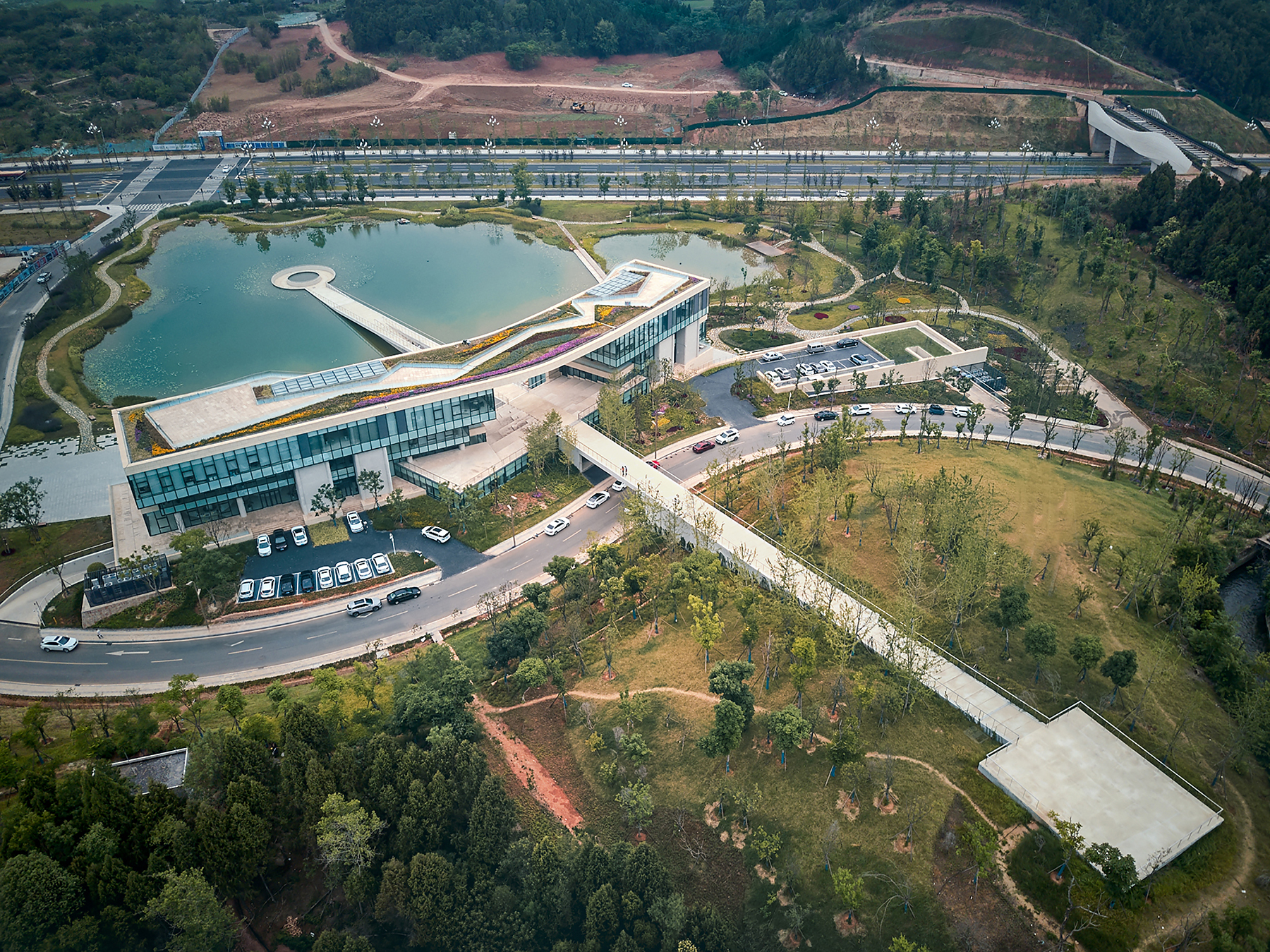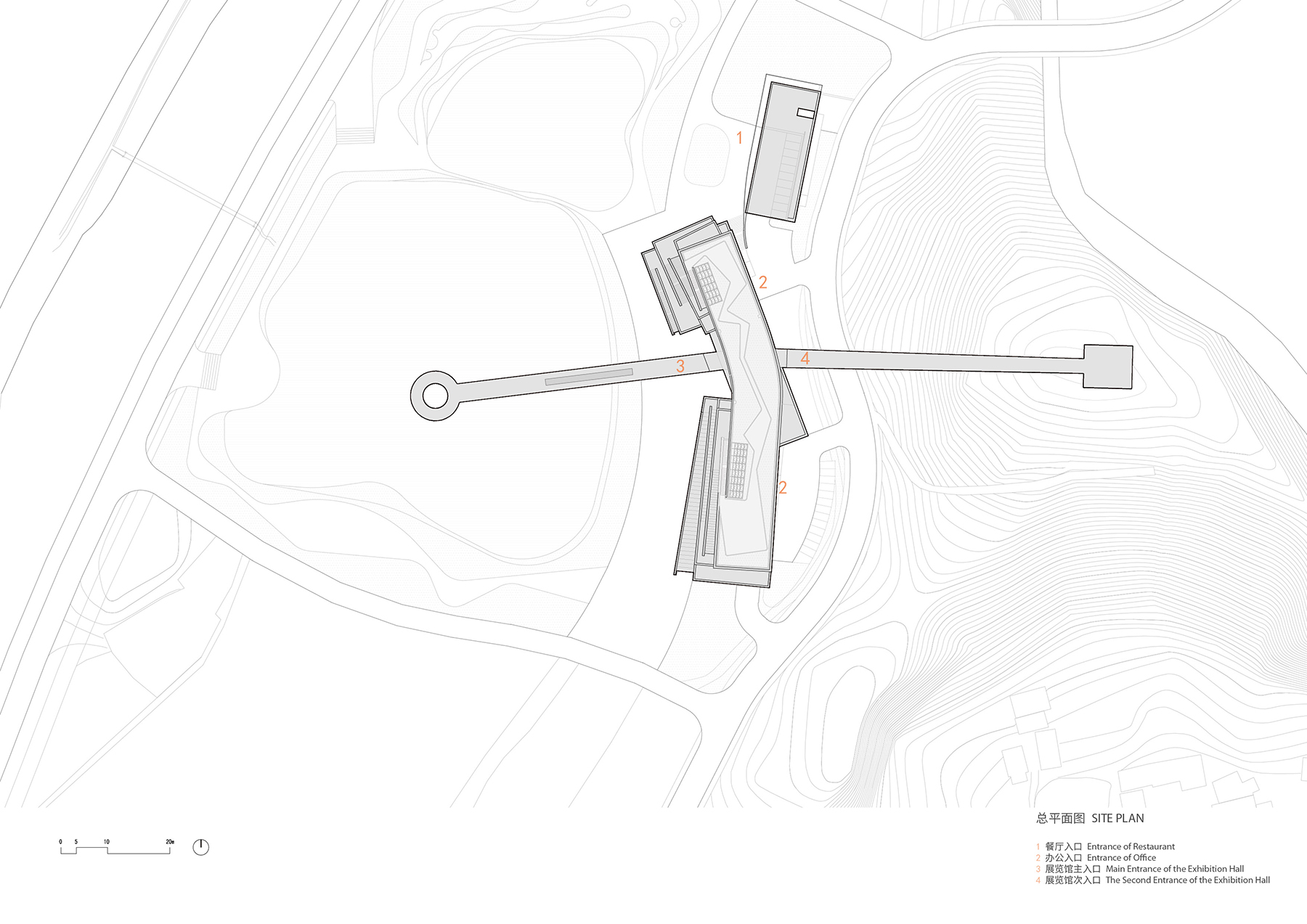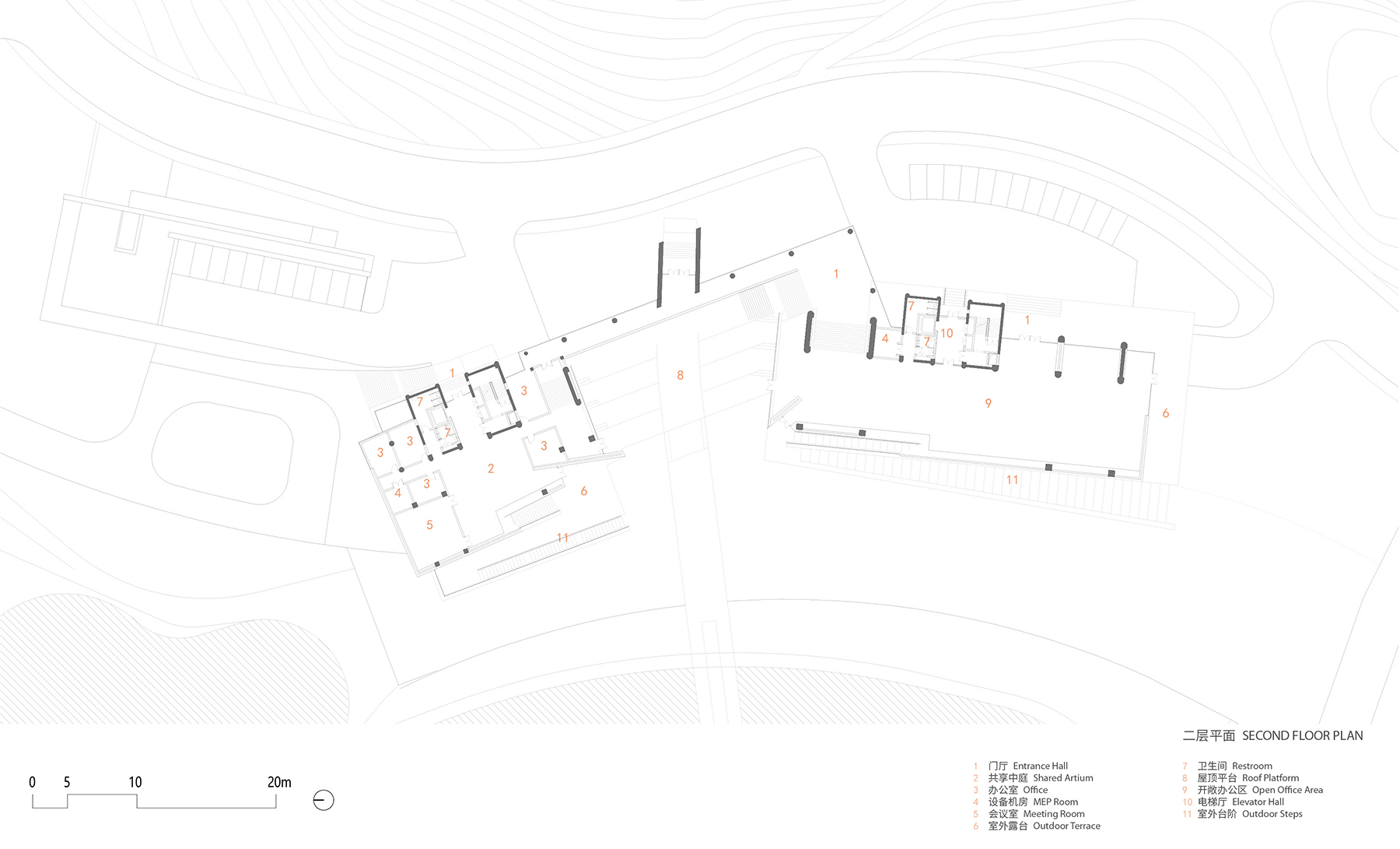
设计单位 BIAD·朱小地工作室
项目地点 四川德阳
建成时间 2023年
建筑面积 7819.93平方米
本文文字由设计单位提供。
凯州新城规划展览馆位于凯州新城启动区范围内,毗邻新城两轴交汇之地。场地的横轴为人民渠公园,是启动区核心景观带;纵轴则为中金快速路,是连接新城市群的纽带。作为城建设和发展的龙头区域,规划展览馆不仅是新城的重要公共空间,也是新城与外界直接互动的展示窗口。
The Kaizhou New Town Planning Exhibition Hall (Window of Kaizhou) is located within the start-up zone of the Kaizhou new town, adjacent to the intersection of the two axes of the new town. The horizontal axis is the People’s Canal Park, which is the core landscape belt of the start-up zone. The vertical axis is the Zhongjiang – Jintang expressway, which is the belt connecting the new urban agglomerations. Being located in the leading development zone of the new town means that the exhibition hall is not only an important public space of the new town, but also the most direct display window of the new town to the outside world.



展览馆基地位于金中快速路的东侧,总占地面积约1.4万平方米。场地西临荷塘,东靠山丘,人民渠经山顶流过。基地的地理区位背山面水,极具当地自然景观特色。一条沿东侧山丘延伸进入村庄谷地的小路,已被拓宽成为进出展览馆的主要道路。
This exhibition hall is located on the east of the Zhongjiang – Jintang expressway, with a total land area of about 14,000m2. It is adjacent to a lotus pond on its west, and the hill on its east. The People’s Canal runs through the top of the hill. This site is thereby characterized by local natural landscape features. There was a path extending from the hill on the east into the valley of the village, which had been expanded as the main road to the exhibition hall.


场地具有较好的景观优势,融合了丰富的自然和人文景观元素,比如荷塘和人民渠。优美的荷塘景观延续了传统农业社会的乡村景观;而人民渠则见证了特定历史时期人们的生产活动。设计团队认为,新城建设需要重新审视人与自然、人与历史的关系。我们需要回应场地周围的特定环境,激活已存在的时空要素,最终明确创作方向。
The site takes advantages of the landscape features both of the natural landscape (lotus pond) and the human landscape (the People’s Canal). The beautiful lotus pond is a continuation to the rural landscape of traditional agricultural society, while the People’s Canal is the witness to human’s production activities in a specific historical period. The architect believes it is necessary to reconsider the relationship between human and nature when developing the new town, which shall response to the specific environment of the site and activate the existing space-time elements to achieve an accurate design intention.


我们将方案结合功能需要,设计一个高度为20米、长度为100米的基本体量。同时,我们还设计了一座穿过建筑的廊桥,将荷塘与山顶连接起来,与建筑体量形成交叉关系。由此,建筑体量的中部形成了一个大尺度的洞口,既形成室外公共空间,又进一步强化这种对话关系。穿越洞口的廊桥使人们在荷塘与山丘间建立起联系,将建筑作为欣赏自然的窗口。原本并非宏大和独特的山水场域,借助观察洞口的视觉约束和释放,凸显了山水景致的存在,并使观者获得新的心理体验。
According to the functional requirements, a 20m-high and 100m-long building is placed in the site as the basic volume. A bridge is designed that goes through the building, connects the lotus pond and the hill, which forms a cross dialogue with the building volume. A large-scale window opens in the middle of the building volume forms an outdoor public space, strengthens such dialogue and highlights the concept of the window. The bridge through the window allows visitor to establish a connection between the lotus pond and the hills, which using the building as a window to view nature. The landscape field, which is not originally grand and unique, is visually constrained and released through the observation of the window, it hints at the existence of the landscape scene and enables the visitor to gain a new psychological experience.


建筑由一个四层的规划展览馆主体和北侧一层的员工食堂组成。规划展览馆主体分为南北两个体量,各自设置有独立的出入口及竖向交通系统。首层门厅是联系展览馆南北体量的核心空间,也是展览馆主要出入口和礼仪空间。门厅的南北两侧分别是展览库房和会议区。建筑从二层开始分为两个体量,然后在屋顶处相连,中间的“窗户”形成一个开放的室外平台。北侧体量的2-4层均为办公区。南侧体量的2-3层为规划展览区,4层则为办公区。
The whole project is comprised of the four-story exhibition hall as the main body and a staff canteen on the north side. The exhibition hall consists of the south volume and the north volume, both of the volumes are equipped with independent entrances and exits as well as vertical transport system. The entrance hall on the first floor is the key space that connects the south and north volumes, and also serves for main entrance and reception. On this floor, the conference area and exhibition storage area are located in each volume. This building is divided into two volumes from the second floor which are joined together again at the roof level. The “window” in the middle is an open outdoor platform. On the north volume, the second to the fourth floors are the office areas. On the south volume, the second to the third floors are the planning exhibition areas, and the fourth floor is the office area.



建筑的窗户主要集中在东立面,为不同功能的空间提供充足的采光和通风。西立面作为主要的展示面,同时避免了西晒,采用了封闭的石墙面。中部的洞口通过两侧建筑在不同楼层的错叠,形成复杂的轮廓。西立面石材包裹的体量以层层退台的方式形成室外平台,折返的台阶联系各层平台,在西立面上勾勒出简洁有力、连续向上的路径,从底层一直延伸到屋顶平台,贯穿整个立面。一方面,它满足了安全疏散的要求,减少了建筑内部交通空间的冗余;另一方面,它削弱了建筑体量的压迫感,创造了更多的形态变化。更为重要的是,这个设计进一步引导了观众的行动路径,在不同的高度和屋顶上,让人们领略建筑与周围环境不同的视角。这里是以现实场景的方式展示新城建设过程的平台。
The window openings are mainly on the east elevation to provide sufficient light and ventilation for the different functional spaces. The west elevation serves as the main display surface while avoiding western exposure with a “solid” surface. The volume of the stone forms the outdoor terraces which set back layer by layer. The interlaced steps connect with the terrace of each floor and become a concise and continuous path that goes through the facade towards the roof platform. Therefore, it can relieve the vertical transport for the evacuation purpose and reduce the redundancy of the interior transport space, and in the meantime, weakens the oppressing sensation of the building volume and brings more changes. More importantly, the design further mobilizes the movement path of the visitors, and allows them to experience the building and the surrounding environment from different perspectives in the vertical direction and at the height of the roof. Therefore, it can be considered as a platform through which visitors may witness the urban development process in a realistic scenario.


人们在其中漫步、穿行、登高、远眺。人、建筑和自然在这里相互交融,历史与现在交相辉映,成为城市中最为生动的舞台,更是展示凯州新城的“未来之窗”。Visitors are walking, passing through and climbing in this building. By integrating human, architecture and nature into a picturesque scene, it becomes the liveliest urban stage and “a window of the future” that shows the landscape and culture of the Kaizhou new town



设计图纸 ▽






完整项目信息
项目名称:凯州之窗
项目类型:文化建筑
项目地点:四川省德阳市凯州新城
设计时间:2020年
建成时间:2023年
用地面积:14100.74平方米
建筑面积:7819.93平方米
业主:德阳市凯州投资开发有限责任公司
设计单位:BIAD·朱小地工作室
主持建筑师:朱小地
设计团队:贾琦、罗盘、孙晓倩、孙栓柱、王烨、马宜勃、李燚、王晓东
结构:陈晗、尹飞
设备:崔玥
电气:毕雅冲
灯光设计:北京光湖普瑞照明设计有限公司 胡芳、李亚辉
室内设计:北京建院装饰工程设计有限公司 石珊珊、杨子霖
摄影:傅兴、韩金波、朱小地
版权声明:本文由BIAD·朱小地工作室授权发布。欢迎转发,禁止以有方编辑版本转载。
投稿邮箱:media@archiposition.com
上一篇:比利时安特卫普皇家美术博物馆改扩建 | KAAN Architecten
下一篇:轻量化结构:黄浦江杨浦大桥水质自动监测站改造工程 / 同济院麟和建筑工作室